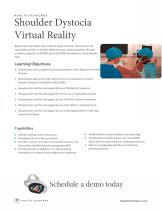
Catalog excerpts

Shoulder Dystocia Virtual Reality Built on the most widely used, evidence-based protocols, Learners have the opportunity to follow a shoulder dystocia scenario from recognition through resolution using the ALARMER and/or HELPER mnemonics in Virtual Reality (VR). Demonstrate early recognition and communication of the diagnosis of shoulder dystocia Demonstrate appropriate order and correct use of maneuvers to resolve shoulder dystocia (ALARMER or HELPERR) Recognize the need for and suggest the use of McRoberts's maneuver Recognize the need for and suggest the correct use of suprapubic pressure Recognize the need for and suggest the use of Wood’s corkscrew maneuver Recognize the need for and suggest the use of the delivery of posterior arm Recognize the need for and suggest the use of attempting delivery of the baby on hands and knees Capabilities ◆ Realistic birthing room environment ◆ Simulation takes less than 10 minutes ◆ Provides a virtual, zero-risk, environment to practice and learn critical shoulder dystocia management skills ◆ Provides learners a readiness score, determined by assessing core competencies throughout the simulation ◆ Health Scholars’ patent-pending voice technology ◆ VR simulation can offer learner 24/7 accessibility which allows for more frequent, independent practice ◆ Delivers in application debriefs to reinforce key learning objectives
Open the catalog to page 1All Health Scholars catalogs and technical brochures
-
Stroke Virtual Reality
1 Pages
-
ACLS Virtual Reality
1 Pages
-
PASS & RACE Virtual Reality
1 Pages










